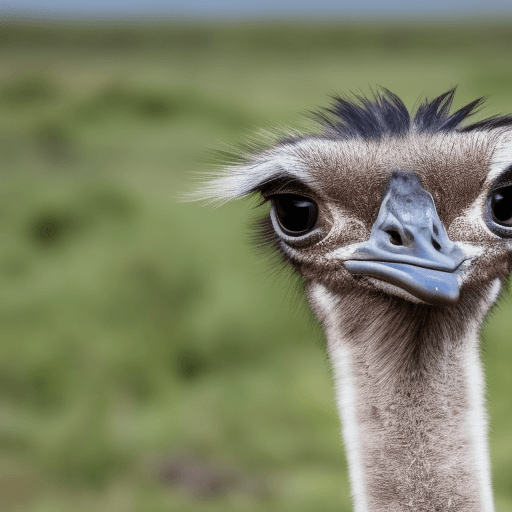When it comes to speed, few animals can rival the ostrich, the largest and heaviest bird on the planet. How fast can an ostrich run? This intriguing question has fascinated bird watchers, researchers, and animal lovers alike. Understanding the running capabilities of the ostrich not only highlights its unique adaptations but also enhances our appreciation for the diversity of the animal kingdom. In this article, we will delve into the incredible speed of ostriches, their physical attributes that contribute to their remarkable running abilities, and how they compare to other fast animals.
Ostriches, native to Africa, are not just remarkable for their size but also for their exceptional speed. They can reach impressive velocities, making them the fastest running birds. Additionally, their long legs and powerful muscles allow them to cover ground quickly and efficiently. This article will provide you with a comprehensive understanding of how fast an ostrich can run, the factors that influence their speed, and their survival instincts in the wild.
As we explore the fascinating world of ostriches, we will also look at some interesting facts about their behavior, diet, and habitat. Whether you are a curious reader or an avid bird enthusiast, this article aims to provide valuable insights into one of nature's most remarkable creatures. So, let's dive into the world of ostriches and discover just how fast these incredible birds can run!
Table of Contents
- Ostrich Speed: An Overview
- Physical Attributes of Ostriches
- Comparison with Other Fast Animals
- Ostrich Survival Strategies
- Behavioral Traits Related to Speed
- Diet and Energy Levels
- Habitat and Its Influence on Speed
- Conclusion: The Remarkable Ostrich
Ostrich Speed: An Overview
The ostrich is renowned for its incredible speed, capable of running at speeds of up to 45 miles per hour (72 kilometers per hour) in short bursts. On average, they maintain a speed of around 30 to 40 miles per hour (48 to 64 kilometers per hour) over longer distances. This remarkable ability allows them to escape predators and cover large areas in search of food and water.
Physical Attributes of Ostriches
To understand the speed of ostriches, it is essential to examine their physical attributes that enable such impressive running capabilities.
Leg Structure and Musculature
Ostriches possess long, powerful legs that are well-adapted for running. Their legs have a unique structure, featuring a long femur and a fused ankle joint, which allows for greater stride length and speed. The muscles in their legs are highly developed, providing the strength needed for rapid acceleration and sustained running.
Weight and Its Impact on Speed
Despite their hefty weight, which can reach up to 320 pounds (145 kilograms), ostriches are surprisingly agile. Their lightweight bones and powerful leg muscles contribute to their ability to run swiftly. The balance of weight and strength is crucial for their running efficiency.
Comparison with Other Fast Animals
When comparing the ostrich's speed to other fast animals, it stands out not only among birds but also in the animal kingdom as a whole. For instance:
- Cheetah: The fastest land animal, capable of reaching speeds up to 75 miles per hour (120 kilometers per hour), but only for short distances.
- Horse: Can run at speeds of around 55 miles per hour (88 kilometers per hour) in short sprints.
- Greyhound: Known for their speed in racing, greyhounds can reach up to 45 miles per hour (72 kilometers per hour).
While the ostrich may not be the fastest overall, its unique adaptations make it the fastest bird on land.
Ostrich Survival Strategies
The ability to run fast is a crucial survival strategy for ostriches. In the wild, they face threats from various predators, including lions, hyenas, and crocodiles. Their speed allows them to evade capture and escape danger effectively.
Behavioral Traits Related to Speed
Ostriches display fascinating behavioral traits that complement their speed. When threatened, they may use a combination of running and hiding to survive. They are also known for their ability to change direction quickly, allowing them to dodge predators.
Diet and Energy Levels
The diet of an ostrich plays a significant role in maintaining their energy levels for running. They primarily feed on:
- Grasses
- Seeds
- Fruits
- Insects and small animals
A well-balanced diet rich in nutrients is essential for sustaining their energy and enhancing their running capabilities.
Habitat and Its Influence on Speed
Ostriches typically inhabit open grasslands and savannas, which provide ample space for running. Their environment plays a vital role in their ability to escape predators and find food. The terrain's flatness allows for unobstructed running, contributing to their speed.
Conclusion: The Remarkable Ostrich
In conclusion, the ostrich is a remarkable bird capable of running at impressive speeds, reaching up to 45 miles per hour. Their unique physical attributes, survival strategies, and behavioral traits all contribute to their ability to thrive in the wild. Understanding how fast ostriches can run not only highlights their incredible adaptations but also emphasizes the importance of preserving their habitats for future generations.
If you found this article informative, feel free to leave a comment, share it with your friends, or explore other articles on our site to learn more about the fascinating world of wildlife!
Thank you for reading! We hope to see you again soon for more intriguing insights into the animal kingdom.
El Paso Clerk And Recorder: Your Ultimate Guide To Services And Information
The Chef And The Farmer Restaurant In Kinston, NC: A Culinary Gem
Family Auto Of Taylor's: A Comprehensive Guide To Your Next Car Purchase


